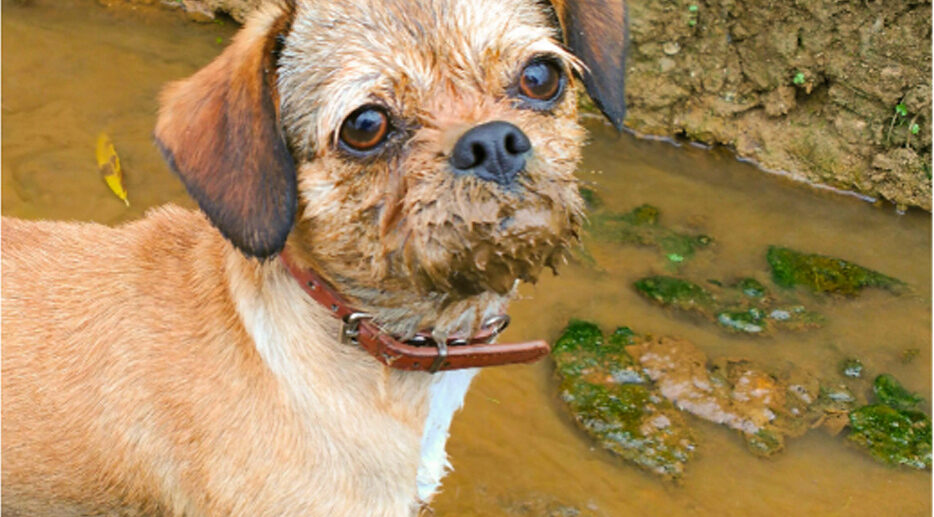Blue-Green Algae: Keep Swimming Dogs Safe From Deadly Blue-Green Algae

As a conscious pet parent, you may have heard alarming stories of dogs suddenly falling ill or passing away after going for a swim.
Blue-green algae toxicity is a hidden danger lurking in lakes and ponds, even in popular swimming spots. Learn why this microorganism is so dangerous to dogs and what you can do to keep your doggy-paddling pup safe on swimming trips.
What is Blue-Green Algae Toxicity?
Blue-green algae isn’t actually algae at all. It’s cyanobacteria, a microorganism that can live in either fresh or saltwater, from lakes and ponds to bays and shorelines. Blue-green algae or cyanobacteria blooms behave like plants, taking in sunlight and nutrients from the water to grow.
The “algae” itself is not toxic. What makes blue-green algae so dangerous is its production of cyanotoxins.
Cyanotoxins in blue-green algae cause skin irritations in mammals, including people, dogs, and livestock that swim in the body of water. If ingested, cyanotoxins affect the liver and nervous system.
Dogs are susceptible to ingesting cyanotoxins when they drink the water, eat dead fish or other wildlife, swallow water while swimming, or lick their paws or coat after swimming.
What are the Symptoms of Blue-Green Algae Toxicity in Dogs?
Dogs can begin to experience symptoms of poisoning in as little as fifteen minutes after initial exposure, though it can take hours, even days for signs to show up.
Symptoms of Blue-Green Toxicity in Dogs:
- Vomiting
- Diarrhea
- Lethargy
- Trouble breathing
- Seizures
- Collapse
- Pale gums
- Sudden death
If your dog has drank from, swam in, or has otherwise been exposed to a body of water that could contain blue-green algae, do not hesitate to seek emergency veterinary care. The sooner your dog is treated, the better chance they will have for survival, though many dogs do not survive blue-green toxicity even with treatment.
What Does Blue-Green Algae Look Like?
Blue-green algae is often described as what looks like a layer of bright “green paint” or “split pea soup,” floating on the water’s surface, though it can also appear red or rust-colored, brown or give the water an overall cloudy appearance, and the water may give off a “swampy” odor.
Toxic blue-green algae is not always obvious or visible. It can change its buoyancy to access nutrients and sunlight, and at times may lurk under the surface of the water. As it’s made up of microscopic organisms, small, dispersed colonies do not always form large, obvious patches. What’s more, toxins can remain shortly after the algae itself has died off.
While not all blue-green algae releases cyanotoxins, it is impossible to tell by looking at a body of water whether or not it’s safe for your pup to go for a swim. Avoid allowing your dog near water that looks cloudy, greenish, or has visible patches of algae, and stay away from secluded bodies of water that have not been cleared for swimming.
Protect Your Dog From Blue-Green Algae Poisoning
Avoid water that shows signs of blue-green algae which may include cloudiness, swirly, foamy, or murky deposits at the surface of the water, dead fish and wildlife, or a swampy odor.
Look for posted signs in swimming areas. Some, but not all waterways are regularly tested for toxicity, and there may be posted signs when it’s not safe to swim.
Avoid secluded swimming spots. Though popular swimming sites can still be affected by blue-green algae, they’re more likely to be regularly tested and to be reported to local authorities if there’s evidence of algae blooms.
Rinse your dog after swimming. Use fresh, clean water to rinse your dog immediately after swimming to prevent them from ingesting toxins while licking their paws or coat.
Keep your dog on-leash especially in areas with posted signs, or if your dog may try to go for a drink or swim without your permission.
Don’t let your dog eat wildlife especially dead fish or birds near water that may have been contaminated.
Why Is Blue-Green Algae Toxicity Becoming More Common?
Over the past decade, cases of blue-green algae toxicity in dogs have skyrocketed.
Toxic algae is becoming more widespread, even in regions that were once unaffected. Peak algae seasons have become longer. While once limited to late summer and early fall, many regions are now seeing outbreaks by springtime.
So, why is toxic algae taking over our dogs’ favorite swimming spots? As it turns out, there are multiple factors that contribute to an environment in which toxic algae can thrive.
Climate change brings longer, hotter seasons and lots of sunshine. Algae can grow when the temperature warms up to 75°F, with peak growth around 85°F. Also, climate change contributes to droughts, which can make freshwater lakes more salty. Increased salinity allows saltwater algae to take over freshwater lakes.
But algae overgrowth is not just a result of our changing climate. It’s also caused by an increase of nutrients in bodies of water.
Certain fertilizers used for farming and on lawns and gardens wash into local waterways, adding phosphorus and nitrogen to the water. Phosphorus-free fertilizer is recommended to protect water quality and prevent algae growth.
As a dog parent, you have a special responsibility to protect waterways: always, always pick up your dog’s poop.
Dog poop, when not properly disposed of, also contaminates waterways with excess nutrients. By not picking up poop, pet parents can inadvertently contribute to the overgrowth of algae that makes dogs fatally ill. By picking up, bagging, and tossing your dog’s poop in the garbage, you can help protect not only your dog, but all animals that live, hunt, and swim in your local lakes and ponds.
VISION
Every pet deserves to live a long, happy, healthy life.





